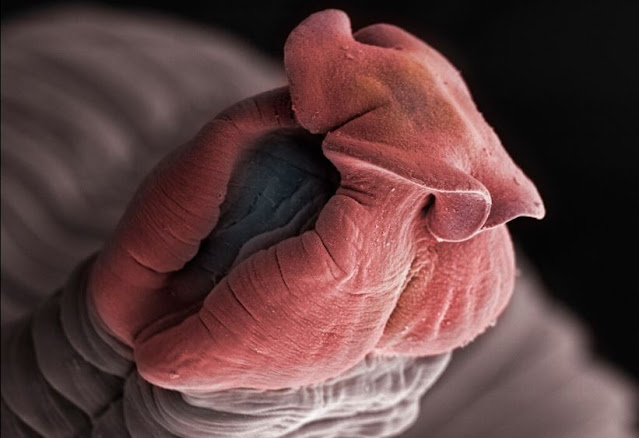HIDDEN WORLD
OF
MICROSCOPIC LIFE REVEALED
IN EXTRAORDINARY PICTURS
By
Søren Nielsen
2021
Squirming around in the dirt, a mealworm may seem unremarkable.
But if your eyes could magnify the beetle larva by a hundred times, its exquisite face would come into focus.
You’d see miniature features that appear so expressive, you might be tempted to anthropomorphize the little rascal.
This is familiar territory for photographer Jannicke Wiik-Nielsen.
Her portraits of insects, parasites, bacteria, and other exceptionally small life—part of a collection dubbed Hidden World—showcase these creatures in ways that make them look less like "creepy crawlies," as she calls them, and more like characters.
She achieves the effect through scanning electron microscopy, a technique that yields high-resolution images through the use of electrons instead of photons.
Antennae akimbo and mouth agape, a hoverfly (also called a flower fly or syrphid fly) seems full of personality when viewed up close.
Hoverflies, which are common throughout the world, feed on pollen and nectar.
"Despite their appearance, which mimics wasps and bees, they are harmless to humans."
"The compound eye is composed of numerous facets," Wiik-Nielsen says, "each of which contains a lens" that together help the insect orientate itself and detect movement.
This is a bee. The structures at the base of its head are called mandibles, which bees use for cutting, eating pollen, and working wax.
This detail of a dog flea reveals one of the parasite's two antennae, which "play a significant role in host-finding, and are also crucial for successful mating."
A dog flea has a mouth designed to pierce skin and suck blood and elongated hind legs to facilitate jumping.
Its body is flat and covered with spines and bristles.
This shape, "helps with forward movement through dense fur, prevents dislodgement, and steadies the flea during feeding."
In scanning electron microscopy, a focused electron beam captures a high-resolution, grayscale image of a specimen by scanning its surface.
Because the beam is sensitive to dust and water, this scanning is done inside a high-vacuum chamber.
After Wiik-Nielsen collects a specimen, she places it in a solution that helps maintain its structure.
Then she dries the sample thoroughly and gives it a thin coat of metal.
This helps the specimen stay intact throughout the imaging process, which takes just a few minutes.
Once an image is made, Wiik-Nielsen uses Photoshop to colorize it.
"Ants form colonies described as superorganisms," Wiik-Nielsen says, "because they appear to operate as a unified entity, collectively working together to support the colony."
A caterpillar, magnified roughly a hundred times, eating broccoli.
The one shown here is magnified approximately 40 times.
"Woodlice breathe with gills, so they are restricted to areas with high humidity, under rocks or logs, in leaf litter or in crevices."
"They feed on decaying plant and animal matter, performing a vital role in the decay cycle."
Wiik-Nielsen’s passion for electron microscopy took hold six years ago.
As a research scientist at the Norwegian Veterinary Institute, she was studying fish eggs that had been infected with a fungus, as well as an amoeba that creates gill disease in farmed salmon.
Her photos of the amoeba caught the attention of the institute’s aquaculture biologists and breeders, she says, "who at long last could actually see the parasite that they were trying to fight."
Wiik-Nielsen was fascinated by the microscope’s capacity to magnify the organisms up to 200,000 times, and it soon became a research tool of choice.
Her favorite subjects are parasites.
Though they may seem gross to many people, Wiik-Nielsen says, things like tapeworms and roundworms become incredible when amplified by an electron microscope.
The images reveal the creatures’ physical characteristics—mouthparts, for example, or the tiny protrusions called microvilli—in wild detail.
(Meet 4 "zombie" parasites that mind-control their host.)
Belonging to the same phylum as coral, sea anemones, and jellyfish, a hydroid (Echtopleura larynx) may look "delicate and soft. But beware,"
The organisms, which are often found attached to underwater ropes, buoys, mussels, and seaweed, feature two rings of stinging tentacles that are used to capture and subdue prey.
In this image, a hydroid uses its tentacles to protect its sexual buds, called gonophores, from external threat.
They do not have a digestive tract, so instead they absorb nutrients from their host's digested food.
A detail of a tapeworm head reveals grooves known as bothria, which the tapeworm uses to attach itself to a host's intestinal wall.
A female roundworm coils around a male whose two needle-like mating structures, called spicules, protrude from its posterior end.
A type of parasitic nematode, roundworms infect fish as well as birds and seals. Identifying them, Wiik-Nielsen says, "is important in terms of seafood safety and public health, as humans may be infected."
Even blood-sucking (and Lyme disease-spreading) deer ticks captivate Wiik-Nielsen.
In an ode to a tick she encountered and then photographed, she wrote, "I was disgusted when you landed on my shoulder.
You thought I was a deer who could save your life. Instead I was a human who could end your life. Now, looking at your face, I feel anything but disgust."
In addition to using the electron microscope to image specimens for research, Wiik-Nielsen uses it—with the institution’s permission and support—to image things she finds in her garden, or when exploring outside with her two young daughters.
"We find crustaceans in the tidal waters, pollen from plants and trees," she says.
"Only our fantasy can limit us!"




























